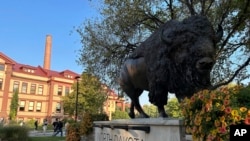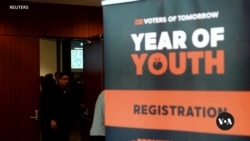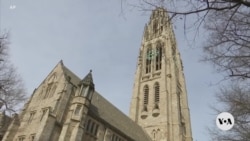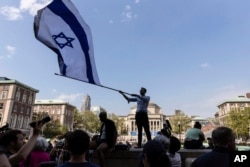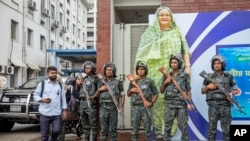Student Union
- By VOA News
Protesters show up at campus encampment created for TV program
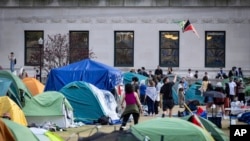
Television crews erected a fictional protest encampment at Queens College while filing an episode of “FBI: Most Wanted,” but real protesters weren’t pleased with the storyline.
Writing in The New York Times, Claire Fahy explains that members of two pro-Palestinian groups felt the show was trivializing their movement, so they gathered nearby and handed out flyers to protest. (July 2024)
US colleges are cutting majors and slashing programs after years of putting it off
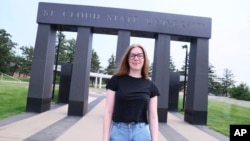
Christina Westman dreamed of working with Parkinson's disease and stroke patients as a music therapist when she started studying at St. Cloud State University.
But her schooling was upended in May when administrators at the Minnesota college announced a plan to eliminate its music department as it slashes 42 degree programs and 50 minors.
It's part of a wave of program cuts in recent months, as U.S. colleges large and small try to make ends meet. Among their budget challenges: Federal COVID relief money is now gone, operational costs are rising and fewer high school graduates are going straight to college.
The cuts mean more than just savings, or even job losses. Often, they create turmoil for students who chose a campus because of certain degree programs and then wrote checks or signed up for student loans.
"For me, it's really been anxiety-ridden," said Westman, 23, as she began the effort that ultimately led her to transfer to Augsburg University in Minneapolis. "It's just the fear of the unknown."
At St. Cloud State, most students will be able to finish their degrees before cuts kick in, but Westman's music therapy major was a new one that hadn't officially started. She has spent the past three months in a mad dash to find work in a new city and sublet her apartment in St. Cloud after she had already signed a lease. She was moving into her new apartment Friday.
For years, many colleges held off making cuts, said Larry Lee, who was acting president of St. Cloud State but left last month to lead Blackburn College in Illinois.
College enrollment declined during the pandemic, but officials hoped the figures would recover to pre-COVID levels and had used federal relief money to prop up their budgets in the meantime, he said.
"They were holding on, holding on," Lee said, noting colleges must now face their new reality.
Higher education made up some ground last fall and in the spring semester, largely as community college enrollment began to rebound, National Student Clearinghouse Research Center data showed.
But the trend for four-year colleges remains worrisome. Even without growing concerns about the cost of college and the long-term burden of student debt, the pool of young adults is shrinking.
Birth rates fell during the Great Recession of 2007 to 2009 and never recovered. Now those smaller classes are preparing to graduate and head off to college.
"It's very difficult math to overcome," said Patrick Lane, vice president at the Western Interstate Commission for Higher Education, a leading authority on student demographics.
Complicating the situation: the federal government's chaotic overhaul of its financial aid application. Millions of students entered summer break still wondering where they were going to college this fall and how they would pay for it. With jobs still plentiful, although not as much as last year, some experts fear students won't bother to enroll at all.
"This year going into next fall, it's going to be bad," said Katharine Meyer, a fellow in the Governance Studies program for the Brown Center on Education Policy at the nonprofit Brookings Institution. "I think a lot of colleges are really concerned they're not going to make their enrollment targets."
Many colleges like St. Cloud State already had started plowing through their budget reserves. The university's enrollment rose to around 18,300 students in fall 2020 before steadily falling to about 10,000 students in fall 2023.
St. Cloud State's student population has now stabilized, Lee said, but spending was far too high for the reduced number of students. The college's budget shortfall totaled $32 million over the past two years, forcing the sweeping cuts.
Some colleges have taken more extreme steps, closing their doors. That happened at the 1,000-student Birmingham-Southern College in Alabama, the 900-student Fontbonne University in Missouri, the 350-student Wells College in New York and the 220-student Goddard College in Vermont.
Cuts, however, appear to be more commonplace. Two of North Carolina's public universities got the green light last month to eliminate more than a dozen degree programs ranging from ancient Mediterranean studies to physics.
Arkansas State University announced last fall it was phasing out nine programs. Three of the 64 colleges in the State University of New York system have cut programs amid low enrollment and budget woes.
Other schools slashing and phasing out programs include West Virginia University, Drake University in Iowa, the University of Nebraska campus in Kearney, North Dakota State University and, on the other side of the state, Dickinson State University.
Experts say it's just the beginning. Even schools that aren't immediately making cuts are reviewing their degree offerings. At Pennsylvania State University, officials are looking for duplicative and under-enrolled academic programs as the number of students shrinks at its branch campuses.
Particularly affected are students in smaller programs and those in the humanities, which now graduate a smaller share of students than 15 years ago.
"It's a humanitarian disaster for all of the faculty and staff involved, not to mention the students who want to pursue this stuff," said Bryan Alexander, a Georgetown University senior scholar who has written on higher education. "It's an open question to what extent colleges and universities can cut their way to sustainability."
For Terry Vermillion, who just retired after 34 years as a music professor at St. Cloud State, the cuts are hard to watch. The nation's music programs took a hit during the pandemic, he said, with Zoom band nothing short of "disastrous" for many public school programs.
"We were just unable to really effectively teach music online, so there's a gap," he said. "And, you know, we're just starting to come out of that gap and we're just starting to rebound a little bit. And then the cuts are coming."
For St. Cloud State music majors such as Lilly Rhodes, the biggest fear is what will happen as the program is phased out. New students won't be admitted to the department and her professors will look for new jobs.
"When you suspend the whole music department, it's awfully difficult to keep ensembles alive," she said. "There's no musicians coming in, so when our seniors graduate, they go on, and our ensembles just keep getting smaller and smaller.
"It's a little difficult to keep going if it's like this," she said.
- By Tina Trinh
Youth engagement reaches new heights this election cycle
Will the youth vote send Kamala Harris or Donald Trump to the White House? Organizers on both sides have seen a swell of voter enthusiasm and support, particularly among young people. But the younger demographic has had a historically low turnout at the polls. VOA’s Tina Trinh explores whether that could change come November.
Policy would help students with job offers get US visas
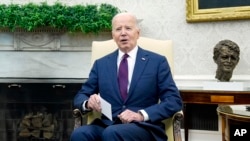
The Biden administration has a plan to ease the U.S. visa process for graduates with job offers.
The goal is to attract top employees and keep skilled workers in the United States, Polly Nash writes in The Pie. (July 2024)
Bangladesh protesters plan to march to capital after deadly clashes
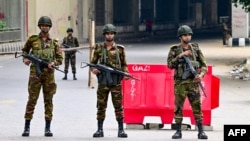
Anti-government protesters across Bangladesh planned to march to the capital, Dhaka, on Monday after a weekend of violence that left dozens of people dead, as the military imposed a curfew for an indefinite period and authorities cut off mobile internet in an attempt to stem the unrest.
At least 95 people, including at least 14 police officers, died in clashes in the capital on Sunday, according to the country's leading Bengali-language daily newspaper, Prothom Alo. Hundreds more were injured in the violence.
The demonstrations began with students seeking to end a quota system for government jobs, but clashes with police and pro-government activists escalated into violence that left more than 200 dead. That prompted protest and opposition leaders to call for Prime Minister Sheikh Hasina to resign in widening protests across the country.
The military-imposed curfew went into effect Sunday night and covered Dhaka and other divisional and district headquarters. The government had earlier imposed a curfew with some exceptions in the capital and elsewhere.
The government also announced a holiday from Monday to Wednesday. Courts were to be closed indefinitely. Mobile internet service was cut off, and Facebook and messaging apps, including WhatsApp, were inaccessible.
Hasina said the protesters who engaged in “sabotage” and destruction were no longer students but criminals, and she said the people should deal with them with iron hands.
The prime minister's ruling Awami League party said the demand for her resignation showed that the protests have been taken over by the main opposition Bangladesh Nationalist Party and the now-banned Jamaat-e-Islami party.
At least 11,000 people have been arrested in recent weeks. The unrest has also resulted in the closure of schools and universities across the country, and authorities at one point imposed a shoot-on-sight curfew.
Over the weekend, protesters called for a “non-cooperation” effort, urging people not to pay taxes or utility bills and not to show up for work on Sunday, a working day in Bangladesh. Offices, banks and factories opened, but commuters in Dhaka and other cities faced challenges getting to their jobs.
The protests began last month as students demanded an end to a quota system that reserved 30% of government jobs for the families of veterans who fought in Bangladesh’s war of independence against Pakistan in 1971.
As the violence crested, the country's Supreme Court ruled that the veterans’ quota must be cut to 5%, with 93% of jobs to be allocated on merit. The remaining 2% will be set aside for members of ethnic minorities and transgender and disabled people. The government accepted the decision, but protesters have continued demanding accountability for the violence they blame on the government's use of force.
Hasina's administration has blamed the opposition parties and their student wings for instigating the violence in which several state-owned establishments were also torched or vandalized.
Mirza Fakhrul Islam Alamgir, secretary-general of the main opposition party, repeated a call for the government to step down to stop the chaos.
Hasina offered to talk with student leaders on Saturday, but a coordinator refused and announced a one-point demand for her resignation. Hasina repeated her pledges to investigate the deaths and punish those responsible for the violence. She said she was ready to sit down whenever the protesters want.
The protests have become a major challenge for Hasina, who has ruled the country for over 15 years. She returned to power for a fourth consecutive term in January in an election that was boycotted by her main opponents.
- By Robin Guess
US colleges reembracing SAT as admissions requirement
The COVID-19 pandemic made it impossible to administer the SAT exam to high school students worldwide. In response, US colleges and universities that required the exam for admissions made the test optional. Now, with the pandemic in the rearview mirror, a trend is growing in higher education to again require the SAT. VOA's Robin Guess has the story.
Students report feeling anxiety about upcoming election
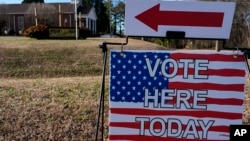
The U.S. presidential election is causing anxiety among some students, according to a report by Tamara Walker in Asbury Park Press.
Despite the anxiety, students also report feeling hopeful about the election. (July 2024)
US student protests challenge balance of speech rights, university policies
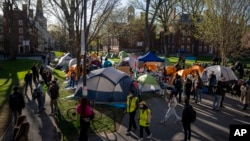
Student protesters on college campuses frequently invoke the First Amendment to shelter their actions, which often include chanting slogans, occupying buildings and setting up encampments. Legal experts have weighed in on how these activities are protected — or not — under the First Amendment to the U.S. Constitution.
This past spring, student protests brought about by the Israel-Hamas war popped up at many U.S. college campuses. The students protested the war's rising death toll and called for universities to separate themselves from companies advancing Israel’s military efforts in Gaza.
In June, Louisiana enacted a new law limiting speech on university campuses in response to pro-Palestinian demonstrations at colleges.
Governor Jeff Landry, a Republican, signed Senate Bill 294, which exempts any act that bears a criminal penalty from free-speech protections. Campus free-speech policies no longer defend civil disobedience, says the website Louisiana Illuminator.
"What we need on college campuses is education, not activists," Republican state Senator Valarie Hodges, who filed the bill, told the Illuminator.
These laws aim to curb civil disobedience and protests, especially those related to the Israel-Hamas conflict.
“We are once again in our history seeing laws that likely target speech, especially speech that some might find objectionable,” Roy Gutterman, director of the Tully Center for Free Speech at Syracuse University, said in an email to VOA.
“We saw it in the Red Scares, during the civil rights movement and during anti-war protests in the 1960s,” he said.
Under the law, “activities in which an individual or group is knowingly being monetarily funded or organized by any individual, corporation, business or organization that has been designated as a foreign terrorist organization or foreign adversary by the United States Department of State” is also barred from protection.
Zach Greenberg of the Foundation for Individual Rights and Expression told VOA that it is important such policies be enforced in “a content viewpoint neutral manner,” meaning that “they can't be enforced against people differently based on what they say and what they believe.”
Gutterman said the First Amendment “is the protection for citizens to be able to speak, publish, gather and complain about government policy without legal restrictions or punishment for that expression.”
“But, of course, there are lots of specific exemptions, like causing a riot, defaming someone and many others,” he told VOA.
These limitations might take many different forms, such as controlling the amount of noise that people can produce, limiting the number of demonstrators who can occupy a certain space, prohibiting protests in the early morning or late at night, and regulating the size and positioning of signs on public property.
Greenberg said that while the First Amendment generally protects students’ right to protest, this protection has limits. "Speech is protected unless it falls into categories like discriminatory harassment or severe disruption," he said.
“Encampments, which are often used in protests, are not typically protected and can be regulated through content-neutral time, place and manner restrictions,” he said, adding that this means the First Amendment does not establish a right to occupy a campus as an expression of protest.
The limitations can also vary based on whether the protest is at a public or a private university.
"Public universities are bound by the First Amendment, whereas private universities are only bound by their own policies, which can act as a contractual obligation to provide free speech," Greenberg said.
Gutterman agreed that private colleges are not bound by the First Amendment in the same way as public colleges but said they still “should operate within the spirit of free speech values and academic freedom.”
He also pointed out that activities such as occupying buildings or setting up encampments generally fall outside First Amendment protections. "You do not have a First Amendment right to stay overnight in a park, and similar restrictions apply on campus," he said.
Last month, The New York Times reported that when police were called in to break up a student encampment at Columbia University in April, it was the first major detainment of protesters. Since then, more than 3,100 people have been arrested or detained on campuses across the country, the Times reported. Most charges were for trespassing or disturbing the peace, but some people have faced more-serious charges, such as resisting arrest.
As student protests evolve, understanding the balance between free speech rights and university policies remains crucial. Universities are required to navigate these issues to protect free speech while maintaining campus safety and order.
College athletes could be considered employees, court rules
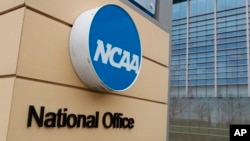
Although college sports have long been considered amateur athletics, a federal appeals court said there should be a legal test to determine when athletes are playing for fun and when they are working for a school or college.
ESPN.com reports that when the efforts of college athletes directly benefit a school, they may be subject to federal wage and hour laws. Defendants in the lawsuit include the NCAA and member schools such as Duke University, Villanova University and the University of Oregon.
Bangladesh faces growing criticism for violent crackdown on students
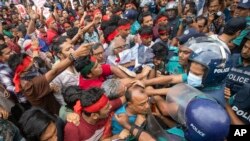
International pressure is mounting on Bangladesh to end its violent crackdown on protesting students after scores of video clips and photos surfaced on social media over the past week showing police, army and paramilitary forces firing directly upon the protesters.
The United Nations, European Union and Amnesty International are among those that have called on the Dhaka government to ease up on the students, who have been demanding an end to quotas for government jobs that would limit their employment prospects.
University teachers have joined in the protests, which began after a July 1 High Court ruling re-establishing the quotas, and analysts say the students are enjoying broad support from ordinary citizens.
According to the quota system, 30% of civil service jobs – considered the steadiest job option for young Bangladeshis in a country facing high unemployment – would be reserved for the grandchildren of those who fought against Pakistan in Bangladesh’s 1971 Liberation War.
The students are demanding a merit-based system of job allocation. However, what started as a nonviolent protest turned violent after police fired bullets, pellets and tear gas at unarmed students.
According to reports by police and hospitals, more than 200 people died in the violence between July 16 and 22. Many deaths remain unregistered with bodies not reaching hospitals and police stations. Unofficial figures have put the death toll between 300 and 500.
Last week, Prime Minister Sheikh Hasina blamed the Bangladesh Nationalist Party [BNP], the largest opposition party in the country, for the unrest. She said that she had ordered the deployment of police, paramilitary and army “to protect the students” but called the protesters “militants.”
Hasina, in office since 2009, has been accused of authoritarianism and corruption. Her party has been accused of rigging the last three general elections, a charge that the party denies.
On July 21, the Supreme Court scrapped most of the quotas and ruled that 93% of government jobs would now be open to candidates on merit, meeting a key demand of the protesters.
However, members of Students Against Discrimination [SAD], whose campaign against job quotas precipitated the unrest, said that the protests would continue until their latest set of demands is met.
A statement from SAD said on Monday that four ministers, including the home and law ministers, must be removed from the Cabinet. They also demanded that the police and pro-ruling party “goons” who fired on the students be arrested and prosecuted for “murdering” unarmed protesters.
In response, the government began arresting student leaders and opposition political activists.
One Dhaka-based rights group, which asked not to be identified for fear of official retaliation, said more than 10,000 people, mostly students, have been arrested over the past few days.
The police have already detained at least 10 of the more than 50 SAD coordinators who are leading the protest. One of the coordinators, who was released from police custody briefly before being detained again, said they were tortured in custody and pressured to call off the protests.
Several student leaders and rights activists said on Tuesday that the police, with the help of the army and paramilitary force, were conducting raids across the country and detaining students. The government is trying its best to demoralize the students and sabotage their protest movement, they said.
"Every night they are conducting block raids and picking up students and young people who took part in the uprising,” said a Bangladesh-based rights activist, who asked not to be identified for fear of reprisal from the government.
“Many of them have become traceless, which means they have become victims of enforced disappearances,” the activist told VOA. “The detained activists are being tortured in custody in the name of remand. This is how the judiciary is collaborating in torturing the students and young activists by sending them in for remand and by denying them bail.”
U.N. Secretary-General Antonio Guterres called attention Monday to the reported mass arrests of thousands of students and political opposition members. U.N. spokesperson Stephane Dujarric said Guterres was “deeply concerned about the situation in Bangladesh.”
“We continue to raise our concerns about the situation in the country with relevant authorities, both in the capital, Dhaka, and here in New York, and we count on Bangladesh to respect and uphold human rights, including as a top troop-contributing country to United Nations peacekeeping missions,” Dujarric said.
Smriti Singh, the regional director for South Asia at Amnesty International, said in a statement Monday that the mass arrest and arbitrary detention of student protesters was a “witch hunt by the authorities to silence anyone who dares to challenge the government.”
“Reports suggest that these arrests are entirely politically motivated, in retaliation for the exercise of human rights,” Singh said.
VOA reached out to the Home Ministry of Bangladesh for a response to the international criticism but has not yet received a response.
Ali Riaz, political analyst and professor of political science at Illinois State University, said the underlying cause of the upheaval is the “sense of disenfranchisement among people, both economic and political.”
“A large number of people are facing dire economic situation while those connected to the regime are plundering and siphoning off money to other countries. On the political front, three consecutive fraudulent elections have left no opportunity for them to participate in politics,” Riaz told VOA. “This is an outburst of these discontents which have transformed the movement.”
Income gap between Black and white US residents shrank between Gen Xers and millennials, study says
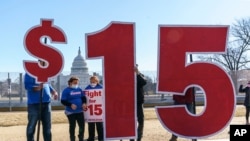
The income gap between white and Black young adults was narrower for millennials than it was for Generation X. That's according to a new study examining income mobility during the two generations that was released last week by researchers at Harvard University and the U.S. Census Bureau.
It also found that the class chasm between white adults born to wealthy and poor parents widened between the generations. The study says that Black people born in 1978 to poor parents ended up earning almost $13,000 a year less than white people born to poor parents by age 27. That gap narrowed to more than $9,500 for those born in 1992.
The income gap between white and Black young adults was narrower for millenials than for Generation X, according to a new study that also found the chasm between white people born to wealthy and poor parents widened between the generations.
By age 27, Black Americans born in 1978 to poor parents ended up earning almost $13,000 a year less than white Americans born to poor parents. That gap had narrowed to about $9,500 for those born in 1992, according to the study released last week by researchers at Harvard University and the U.S. Census Bureau.
The shrinking gap between races was due to greater income mobility for poor Black children and drops in mobility for low-income white children, said the study, which showed little change in earnings outcomes for other race and ethnicity groups during this time period.
A key factor was the employment rates of the communities that people lived in as children. Mobility improved for Black individuals where employment rates for Black parents increased. In communities where parental employment rates declined, mobility dropped for white individuals, the study said.
"Outcomes improve ... for children who grow up in communities with increasing parental employment rates, with larger effects for children who move to such communities at younger ages," said researchers, who used census figures and data from income tax returns to track the changes.
In contrast, the class gap widened for white people between the generations — Gen Xers born from 1965 to 1980 and millennials born from 1981 to 1996.
White Americans born to poor parents in 1978 earned about $10,300 less than than white Americans born to wealthy parents. For those born in 1992, that class gap increased to about $13,200 because of declining mobility for people born into low-income households and increasing mobility for those born into high-income households, the study said.
There was little change in the class gap between Black Americans born into both low-income and high-income households since they experienced similar improvements in earnings.
This shrinking gap between the races, and growing class gap among white people, also was documented in educational attainment, standardized test scores, marriage rates and mortality, the researchers said.
There also were regional differences.
Black people from low-income families saw the greatest economic mobility in the southeast and industrial Midwest. Economic mobility declined the most for white people from low-income families in the Great Plains and parts of the coasts.
The researchers suggested that policymakers could encourage mobility by investing in schools or youth mentorship programs when a community is hit with economic shocks such as a plant closure and by increasing connections between different racial and economic groups by changing zoning restrictions or school district boundaries.
"Importantly, social communities are shaped not just by where people live but by race and class within neighborhoods," the researchers said. "One approach to increasing opportunity is therefore to increase connections between communities."
UCLA ordered by judge to craft plan in support of Jewish students
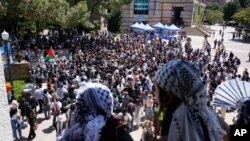
A federal judge ordered Monday that the University of California, Los Angeles, craft a plan to protect Jewish students, months after pro-Palestinian protests broke out on campus.
Three Jewish students sued the university in June, alleging that they experienced discrimination on campus amid demonstrations against the Israel-Hamas war. Yitzchok Frankel, a UCLA law student who is Jewish, said in the lawsuit that he declined an invitation from the director of student life to help host a lunch gathering because he did not feel safe participating.
"Under ordinary circumstances, I would have leapt at the chance to participate in this event," Frankel said. "My Jewish identity and religion are integral to who I am, and I believe it is important to mentor incoming students and encourage them to be proud of their Judaism, too."
But Frankel argued UCLA was failing to foster a safe environment for Jewish students on campus.
UCLA spokesperson Mary Osako said the school is "committed to maintaining a safe and inclusive campus, holding those who engaged in violence accountable, and combatting antisemitism in all forms."
"We have applied lessons learned from this spring's protests and continue to work to foster a campus culture where everyone feels welcome and free from intimidation, discrimination and harassment," Osako said in a statement.
The University was ordered to craft a proposed plan by next month.
The demonstrations at UCLA became part of a movement at campuses across the country against the Israel-Hamas war. At UCLA, law enforcement ordered in May that over a thousand protesters break up their encampment as tensions rose on campus. Counter-demonstrators had attacked the encampment overnight, and at least 15 protesters suffered injuries. In June, dozens of protesters on campus were arrested after they tried to set up a new encampment.
Gap year between high school and college can benefit students
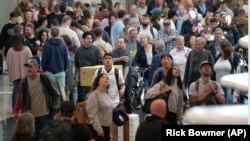
Most students in the United States go straight to college after finishing high school, but some experts say a yearlong break can be beneficial.
Robert Farrington writes in Forbes that a gap year can allow students to travel, learn a foreign language, earn money or become more focused about their goals. (July 2024)
Payments to college athletes to range from a few dollars to more than $1M under settlement

Thousands of former college athletes in the U.S. will be eligible for payments ranging from a few dollars to more than a million under the $2.78 billion antitrust settlement agreed to by the NCAA and five power conferences, a deal that also paves the way for schools to directly compensate athletes while attempting regulate payments from boosters.
Details of the sprawling plan were filed Friday in federal court in the Northern District of California, a little more than two months after the framework of an agreement was announced. The deal must still be approved by a judge.
"College athletes will finally be able to share in the billions of dollars their compelling stories and dynamic performances have generated for their schools, conferences, and the NCAA," the filing said. "This is nothing short of a seismic change to college sports following more than four years of hard-fought victories in this case."
The full term sheet includes guidelines on roster caps for individual sports that will replace scholarship limits; how the new financial payments will be monitored and enforced to ensure compliance by schools; how third-party payments to athletes will be regulated; and how nearly $3 billion in damages will be doled out over the next 10 years.
Those payouts will vary drastically and are determined by sport played, when, how long and what conference an athlete competed in. While Division I athletes across all sports will be eligible to collect damages, the majority of damages is expected to go to football and basketball players from power conferences because those leagues and teams generate most of the revenue that comes from billion-dollar media rights contracts.
The deal covers three antitrust cases — including the class-action lawsuit known as House vs. the NCAA — that challenged NCAA compensation rules dating to 2016. The plaintiffs claimed NCAA rules denied thousands of athletes the opportunity to earn millions of dollars off the use of their names, images and likenesses.
The NCAA lifted its ban on athletes earning money through endorsement and sponsorship deals in 2021.
The agreement does not settle the issue of whether college athletes should be deemed employees, but it does include language that would suggest the deal would be subject to change if "a change in law or circumstances permits collective bargaining."
The NCAA and college sports leaders continue to plead for help from Congress in the form of a federal law that would supersede state laws and allow the association and conferences to self govern without fear of future antitrust litigation.
"This settlement is an important step forward for student-athletes and college sports, but it does not address every challenge," the commissioners of the Atlantic Coast Conference, Big Ten, Big 12, Pac-12, Southeastern Conference and NCAA President Charlie Baker said in a joint statement. "The need for federal legislation to provide solutions remains. If Congress does not act, the progress reached through the settlement could be significantly mitigated by state laws and continued litigation."
While that help still seems unlikely to come soon — especially with a presidential election months away — college sports leaders hope the settlement can provide some certainty for schools and finally stem the constant legal attacks on its antiquated model of amateurism.
Paying athletes
The NCAA and conferences have agreed to amend their rules to permit a landmark compensation system that allows schools to share up to about $21 million in athletic revenues with their athletes annually, starting in 2025.
The NCAA and conferences will be permitted to make rules that prevent schools from circumventing the cap.
That number is derived from taking 22% of the average revenue generated through media rights contracts, tickets and other sources by power conference schools. The agreement will create an audit system that allows plaintiffs to monitor athletic revenue, which is expected to rise in the coming years as new media rights agreements kick in for conferences and the College Football Playoff.
Athletes are projected to receive $1.5 billion to $2 billion annually.
All athletes will be eligible to receive the new financial benefits, but each school will be permitted to determine how they want to divvy up the money among sports. How exactly Title IX gender equity rules apply is still unclear and will require federal clarification. How schools comply with Title IX will be the responsibility of each institution.
Scholarships and rosters
Replacing scholarship limits with roster caps could mean even more athletic scholarship opportunities in Division I.
Most notably, major college football teams will now be permitted to have 105 player on scholarship instead of the current 85, though schools will no longer be required to give full scholarships to every football player.
Partial scholarships have been used in some sports for years, but will now be permitted in all.
The roster caps for baseball (34), softball (25) and volleyball (18) will also allow for a significant jump in the number of scholarships schools can provide in those sports, though schools will not be required to meet the cap.
NIL deals and oversight
NCAA rules have been tweaked to allow schools to be more involved in providing NIL opportunities for college athletes, but they will still be allowed to strike deals with third parties.
However, athletes will be required to report deals with third parties that surpass $600 to an outside clearinghouse.
The NCAA is also creating a public database that it hopes will allow athletes to assess fair market value.
Booster-funded NIL collectives have become a common way athletes are compensated, but now those deals will be subject to review through an arbitration process to determine if it is for a "valid business purpose," according to the agreement.
Violations could lead to eligibility penalties for athletes and sanctions for schools.
Damage payments
The plaintiffs in the House case are responsible for doling out damages. Included in Friday's filing was a chart breaking down the categories of eligible athletes along with four different types of payouts they could be in line to receive.
According to the plaintiffs, about 19,000 power conference football players and men's basketball players will be in line to receive an average of $91,000, with payments ranging from $15,000 to $280,000 just for what is referred to broadcast name, image and likeness.
Some of those same athletes could also be in line for tens of thousands of dollars more related to lost opportunities to earn NIL money while in college and what is deemed by the plaintiffs as pay-for-play. Plaintiffs' lawyers say a few athletes will be eligible to receive upward of $1 million.
Next steps
Plaintiffs' attorneys say they will file a motion for preliminary approval and — if granted — a public website will go up in about two months where former college athletes can determine how much they are eligible to receive.
Still, the settlement is months away from final approval. There will be an opportunity for athletes who are members of the plaintiffs' class to object to the settlement and ask to be excluded. Already one school, Houston Christian, has objected — though the judge denied its request to intervene.
"We are moving forward in the right direction by giving college athletes what they have EARNED & DESERVE which has been long overdue," said Sedona Prince, a college basketball player now at TCU and one of the plaintiffs in the House case. "We still have a long way to go and I pray athletes ask more questions and demand more answers from the leaders at their schools, conferences and the NCAA."
Survey: US college students score low in civic literacy

A recent survey commissioned by the American Council of Trustees and Alumni found that college student in the United States are lacking in civic education.
Writing for Ed Source, Emma Gallegos reports that most of those surveyed don’t know the terms lengths for members of Congress, and a third couldn’t identify the speaker of the House of Representatives. (July 2024)




